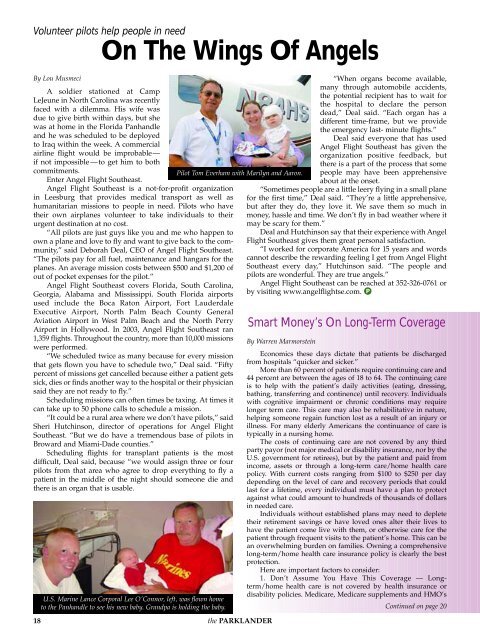Cover_Jan 05 (Page 2) - The Parklander Magazine
Cover_Jan 05 (Page 2) - The Parklander Magazine
Cover_Jan 05 (Page 2) - The Parklander Magazine
- No tags were found...
You also want an ePaper? Increase the reach of your titles
YUMPU automatically turns print PDFs into web optimized ePapers that Google loves.
Volunteer pilots help people in need<br />
On <strong>The</strong> Wings Of Angels<br />
By Lou Musmeci<br />
A soldier stationed at Camp<br />
LeJeune in North Carolina was recently<br />
faced with a dilemma. His wife was<br />
due to give birth within days, but she<br />
was at home in the Florida Panhandle<br />
and he was scheduled to be deployed<br />
to Iraq within the week. A commercial<br />
airline flight would be improbable—<br />
if not impossible —to get him to both<br />
commitments.<br />
Pilot Tom Everham with Marilyn and Aaron.<br />
Enter Angel Flight Southeast.<br />
Angel Flight Southeast is a not-for-profit organization<br />
in Leesburg that provides medical transport as well as<br />
humanitarian missions to people in need. Pilots who have<br />
their own airplanes volunteer to take individuals to their<br />
urgent destination at no cost.<br />
“All pilots are just guys like you and me who happen to<br />
own a plane and love to fly and want to give back to the community,”<br />
said Deborah Deal, CEO of Angel Flight Southeast.<br />
“<strong>The</strong> pilots pay for all fuel, maintenance and hangars for the<br />
planes. An average mission costs between $500 and $1,200 of<br />
out of pocket expenses for the pilot.”<br />
Angel Flight Southeast covers Florida, South Carolina,<br />
Georgia, Alabama and Mississippi. South Florida airports<br />
used include the Boca Raton Airport, Fort Lauderdale<br />
Executive Airport, North Palm Beach County General<br />
Aviation Airport in West Palm Beach and the North Perry<br />
Airport in Hollywood. In 2003, Angel Flight Southeast ran<br />
1,359 flights. Throughout the country, more than 10,000 missions<br />
By Warren Marmorstein<br />
were performed.<br />
“We scheduled twice as many because for every mission<br />
that gets flown you have to schedule two,” Deal said. “Fifty<br />
percent of missions get cancelled because either a patient gets<br />
sick, dies or finds another way to the hospital or their physician<br />
said they are not ready to fly.”<br />
Scheduling missions can often times be taxing. At times it<br />
can take up to 50 phone calls to schedule a mission.<br />
“It could be a rural area where we don’t have pilots,” said<br />
Sheri Hutchinson, director of operations for Angel Flight<br />
Southeast. “But we do have a tremendous base of pilots in<br />
Broward and Miami-Dade counties.”<br />
Scheduling flights for transplant patients is the most<br />
difficult, Deal said, because “we would assign three or four<br />
pilots from that area who agree to drop everything to fly a<br />
patient in the middle of the night should someone die and<br />
there is an organ that is usable.<br />
18<br />
U.S. Marine Lance Corporal Lee O'Connor, left, was flown home<br />
to the Panhandle to see his new baby. Grandpa is holding the baby.<br />
the PARKLANDER<br />
“When organs become available,<br />
many through automobile accidents,<br />
the potential recipient has to wait for<br />
the hospital to declare the person<br />
dead,” Deal said. “Each organ has a<br />
different time-frame, but we provide<br />
the emergency last- minute flights.”<br />
Deal said everyone that has used<br />
Angel Flight Southeast has given the<br />
organization positive feedback, but<br />
there is a part of the process that some<br />
people may have been apprehensive<br />
about at the onset.<br />
“Sometimes people are a little leery flying in a small plane<br />
for the first time,” Deal said. “<strong>The</strong>y’re a little apprehensive,<br />
but after they do, they love it. We save them so much in<br />
money, hassle and time. We don’t fly in bad weather where it<br />
may be scary for them.”<br />
Deal and Hutchinson say that their experience with Angel<br />
Flight Southeast gives them great personal satisfaction.<br />
“I worked for corporate America for 15 years and words<br />
cannot describe the rewarding feeling I get from Angel Flight<br />
Southeast every day,” Hutchinson said. “<strong>The</strong> people and<br />
pilots are wonderful. <strong>The</strong>y are true angels.”<br />
Angel Flight Southeast can be reached at 352-326-0761 or<br />
by visiting www.angelflightse.com. ● P<br />
Smart Money’s On Long-Term <strong>Cover</strong>age<br />
Economics these days dictate that patients be discharged<br />
from hospitals “quicker and sicker.”<br />
More than 60 percent of patients require continuing care and<br />
44 percent are between the ages of 18 to 64. <strong>The</strong> continuing care<br />
is to help with the patient’s daily activities (eating, dressing,<br />
bathing, transferring and continence) until recovery. Individuals<br />
with cognitive impairment or chronic conditions may require<br />
longer term care. This care may also be rehabilitative in nature,<br />
helping someone regain function lost as a result of an injury or<br />
illness. For many elderly Americans the continuance of care is<br />
typically in a nursing home.<br />
<strong>The</strong> costs of continuing care are not covered by any third<br />
party payor (not major medical or disability insurance, nor by the<br />
U.S. government for retirees), but by the patient and paid from<br />
income, assets or through a long-term care/home health care<br />
policy. With current costs ranging from $100 to $250 per day<br />
depending on the level of care and recovery periods that could<br />
last for a lifetime, every individual must have a plan to protect<br />
against what could amount to hundreds of thousands of dollars<br />
in needed care.<br />
Individuals without established plans may need to deplete<br />
their retirement savings or have loved ones alter their lives to<br />
have the patient come live with them, or otherwise care for the<br />
patient through frequent visits to the patient’s home. This can be<br />
an overwhelming burden on families. Owning a comprehensive<br />
long-term/home health care insurance policy is clearly the best<br />
protection.<br />
Here are important factors to consider:<br />
1. Don’t Assume You Have This <strong>Cover</strong>age — Longterm/home<br />
health care is not covered by health insurance or<br />
disability policies. Medicare, Medicare supplements and HMO’s<br />
Continued on page 20
















